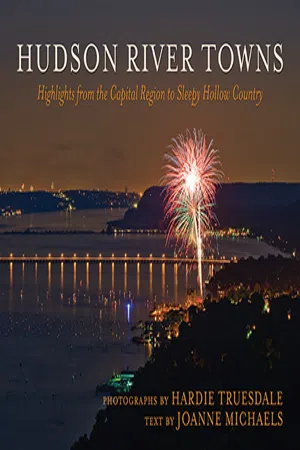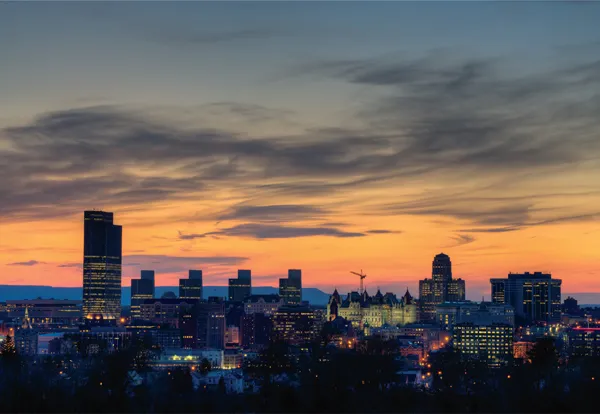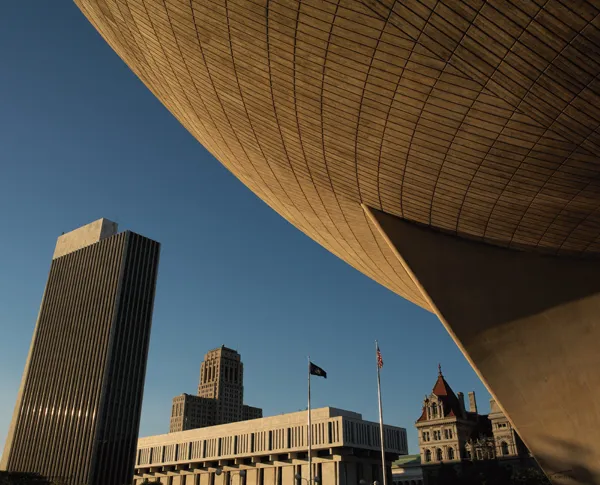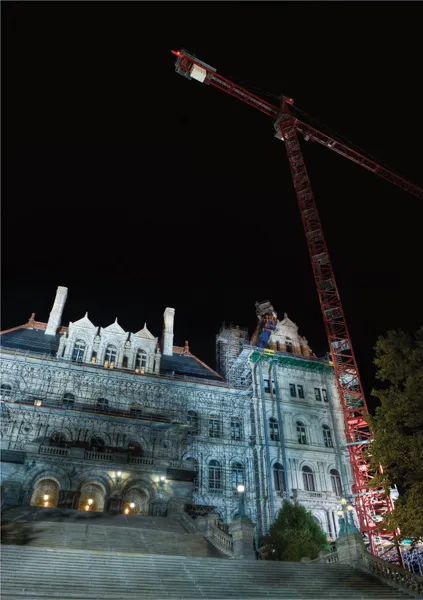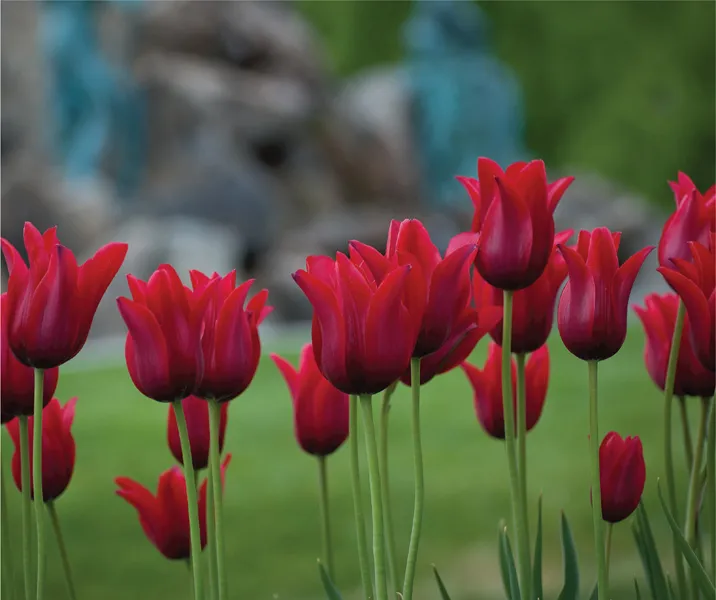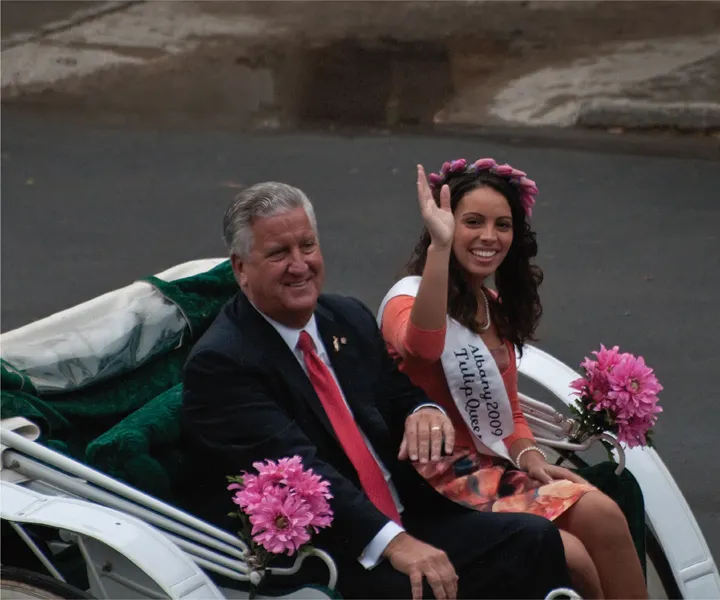![]()
UPPER HUDSON VALLEY
Albany skyline
Albany
In 1609, while seeking a trade route to the Far East, Henry Hudson came upon “La Grande Rivière,” the name given to the Hudson River by early French explorers in the mid-sixteenth century. The Dutch named the river for Henry Hudson, and in 1624 the first settlers, including French Walloons, began a colony named Fort Orange (where Albany is today) for the House of Orange, the royal family of the Netherlands. Soon the Dutch West India Company established a trading post at Fort Orange. And in 1652 Peter Stuyvesant, governor of New Netherland, changed the name of the settlement to Beverwyck.
In 1664 when the Dutch surrendered to the British without armed conflict, King Charles II granted New Netherland, New England, Long Island, and Delaware to his brother James, the Duke of both York and Albany. It was then that Beverwyck became Albany and New Amsterdam became New York.
When the Dutch explorers and traders arrived in the lower Hudson River Valley after the exploration of Henry Hudson in the early seventeenth century, they discovered a Native American economy that included farming, hunting, and gathering. The Native Americans raised corn, beans, squash, and tobacco; gathered berries; and hunted game. The arrival of the Dutch settlers enhanced and changed their basic economy. In the latter part of the seventeenth century the fur trade grew in importance. The settlers also introduced the concept of purchasing land—an idea that was entirely alien to the Native Americans and irrevocably changed their existence.
During the Revolutionary War period (1775–1783), Albany was a strategic location for planning military maneuvers and storing supplies. Albany residents Philip Schuyler, Peter Gansevoort, and Abraham Ten Broeck were all generals in the war. In fact, the Schuyler Mansion, now a state historic site, was where British military officer General John Burgoyne was held after his surrender in the Battle of Saratoga, the turning point of the Revolution. George Washington, Alexander Hamilton, John Jay, and Aaron Burr were also guests at General Schuyler's home during the Colonial period.
In 1797 Albany became the permanent capital of New York State and throughout the nineteenth century Albany became an important transportation center, accessible by land via stagecoach and water by steamboat (after 1807). With the opening of the Erie Canal in 1825, goods could more easily travel westward. And in 1831 railroad travel began with the first trip between Albany and Schenectady. Twenty years later, one could travel by rail between Manhattan and Albany.
While Albany's history spans over four hundred years, few of its earliest historical structures have survived. Many Colonial and Revolutionary War era buildings were destroyed over the years. Some sites that did survive into the twentieth century were leveled and replaced by modern structures like the Empire State Plaza and the Times Union Center.
Located approximately midway between the source of the Hudson River at Lake Tear of the Clouds in the Adirondacks and Manhattan, Albany has had a colorful history. The song “Yankee Doodle” was written at Fort Crailo in the city in 1775. Robert Fulton's steamship, Clermont, made its first trip from New York City to Albany in 1807. The oldest church pulpit in America, carved in Holland in 1656, can be found in Albany's Dutch First Reformed Church. Four New York governors eventually became president—Grover Cleveland, Theodore Roosevelt, FDR, and Martin Van Buren—more than any other state. Erastus Corning II was mayor of Albany from 1942 to 1983, the longest single mayoral term of any major city in America. And perforated toilet paper originated in the city as well; Albany resident Seth Wheeler began selling it in 1877.
The Egg
The Egg, a landmark that defines the Albany skyline, is perched quite remarkably in the Empire State Plaza. Built between 1966 and 1978, it is not at all fragile. In fact, a concrete skirt surrounding the Egg is attached to a stem that reaches down six stories into the plaza to support the weight of this peculiarly inclined structure. Some visitors have noticed that once inside all sense of elevation and direction seems to disappear and a vague sense of disorientation sets in.
How did this distinctive creation come to be? City legend claims the birth of the Egg occurred at the breakfast table. One morning when Governor Nelson Rockefeller was dining with Empire State Plaza architect Wallace Harrison, they discussed the need for a building that would break up the vertical lines of the towers on the plaza. The governor looked down at the half grapefruit on his plate and placed it on a small pitcher of cream. “It should look like that!” he said. And Harrison, inspired sufficiently by the governor's vision, carried it out.
Construction costs ran close to 100 million in 1970 dollars and the building was called The Meeting Center since its intended use was for government meetings in the capital. After completion, however, people immediately began referring to it as the Egg; eventually the name stuck and became official. The building was extremely controversial at the time and one critic described it as a “futuristic Italian bidet.” Today, most of us can't imagine the city of Albany without the Egg, a popular performing arts venue and cultural treasure. The design continues to be a subject of intense disagreement: some love the building and others feel it is devoid of any artistic value.
The Egg
New York State Museum
Anchoring one end of the Empire State Plaza, the New York State Museum has been an integral part of the state's history since 1836, making it one of the oldest museums in America. A wonderful destination for young children, it is chock-full of multimedia presentations and interactive exhibits that bring to life the changing face of the Empire State over the centuries.
Capitol Building
For visitors to Albany, a tour of the Capitol building is a must. One of the highlights of the tour is the Great Western Staircase, also known as the Million Dollar Staircase, perhaps the most renowned of all the building's embellishments. Completed in 1881, it took several years to construct this 119-foot-high staircase made of Corsehill freestone imported from Scotland. To do the job, 600 stone carvers were hired to hand-carve 77 famous faces into the pillars. Some of them are George Washington, Abraham Lincoln, Thomas Jefferson, Alexander Hamilton, Benjamin Franklin, Christopher Columbus, Susan B. Anthony, Walt Whitman, and Harriet Beecher Stowe. Once these renowned Americans were carved, the artisans were permitted to include the faces of friends and family members, and they did. These carvings are known as the “Capitol Unknowns.”
State Capitol Building, Albany
Cityscape
Albany is privileged to have some of the most beautiful sunsets year-round, and the skyline looks particularly dramatic at dusk during the icy-cold winters. Calm settles over the city at the end of the day as it empties out and people head north, south, east, and west. Many people think of Albany as a government town but it is a dynamic city, a mosaic of architectural styles and a melting pot of nationalities, firmly rooted in history yet continually changing. It is a city of lively neighborhoods, each with its own distinctive character, melding past and present at every turn.
College of Nanoscale Science and Engineering
The College of Nanoscale Science and Engineering of the University at Albany is the first college in the world dedicated to research, development, and education in the emerging disciplines of nanoscience, nanoengineering, and nanoeconomics. Founded in 2001 and combining the vision of government, academia, and industry, over 5.5 billion dollars has been invested in this complex; there are over 250 global corporate partners making this center the most advanced research complex at any university in the world.
Tulip Festival / Pinksterfest
The oldest chartered city in the United States, Albany is also the second oldest continually inhabited settlement in America, an important river stop and trading center. A visit to the city today reflects Albany's Dutch origins. The Pinksterfest, a weekend celebration in May, welcomes the spring in the Dutch tradition complete with tulip festival.
Tulips in Washington Park
The Tulip Festival is centered around Washington Park where over 200,000 blossoms, a magnificent sea of color, featuring 140 different kinds of tulips, usher in spring. This annual celebration of the city's rich Dutch heritage dates back to July 1, 1948, when Mayor Erastus Corning passed a city ordinance designating the tulip as the official flower of Albany. He asked Queen Wilhelmina of the Netherlands to select a type of tulip to be the flower of the city. She chose the “Orange Wonder.” The following spring, in May 1949, the first Tulip Festival took place in Albany and the event has grown over the decades. A couple of traditions, however, have remained the same. A Tulip Queen is crowned by the mayor in Washington Park with a festive Tulip Ball following in the evening. The opening ceremonies always begin with the scrubbing of State Street. In Holland, streets were always thoroughly cleaned in this manner before any celebration. The original Dutch streets were dirt and cobblestone and the scrubbing removed what the horses left behind. These days the Tulip Festival is a free family-friendly event welcoming everyone with outdoor entertainment, food vendors, crafts, clowns, music, and activities for children. Of course, the strikingly beautiful tulips are the stars of the show!
Albany Mayor Jerry Jennings and a former Tulip Queen, Juli...
